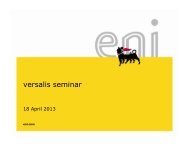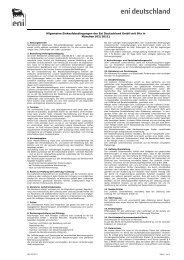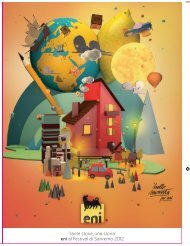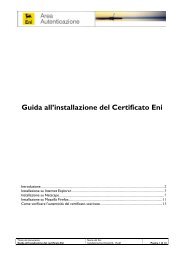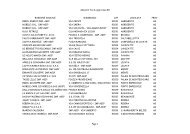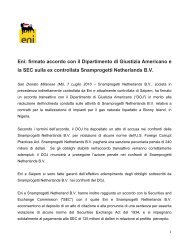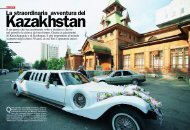È in corso il restauro conservativo del Duomo di Milano. Un ... - Eni
È in corso il restauro conservativo del Duomo di Milano. Un ... - Eni
È in corso il restauro conservativo del Duomo di Milano. Un ... - Eni
You also want an ePaper? Increase the reach of your titles
YUMPU automatically turns print PDFs into web optimized ePapers that Google loves.
FOCUS<br />
chiede <strong>di</strong> riscoprire la propria storia <strong>di</strong> fede, ci<br />
chiama quasi a “toccare con mano”, ad “att<strong>in</strong>gere<br />
alle sorgenti” <strong>del</strong>la nostra esperienza cristiana,<br />
riassunta e descritta nella Cattedrale,<br />
che – come poeticamente canta la liturgia nella<br />
festa <strong>del</strong>la sua De<strong>di</strong>cazione – è immag<strong>in</strong>e<br />
<strong>del</strong>la Chiesa “e<strong>di</strong>ficata con pietre vive ed elette”.<br />
L’“attività liturgica” rappresenta qu<strong>in</strong><strong>di</strong> la<br />
vera anima <strong>del</strong>la Cattedrale e non può che<br />
confrontarsi quoti<strong>di</strong>anamente con le mutate<br />
con<strong>di</strong>zioni socio-culturali dei nostri tempi. Il<br />
<strong>Duomo</strong> è luogo simbolo <strong>del</strong>la tra<strong>di</strong>zione ambrosiana.<br />
Questo è certamente vero e va sostenuto<br />
con conv<strong>in</strong>zione: si pensi allo stesso<br />
Rito ambrosiano, al Canto ambrosiano e ad alcune<br />
particolarità liturgiche tipiche <strong>del</strong>la Cattedrale,<br />
soprattutto quando a presiedere è<br />
l’Arcivescovo. Tuttavia questa sapienza celebrativa<br />
non è pura “conservazione”: essa “cont<strong>in</strong>ua<br />
dall’antico”, nella ripetizione <strong>di</strong> gesti e<br />
parole “antiche” non si portano avanti quasi<br />
<strong>del</strong>le “preziose reliquie”, ma si riscopre una<br />
tra<strong>di</strong>zione vivificata dal “soffio” <strong>del</strong>la Riforma<br />
liturgica. Lo stesso Capitolo dei Canonici ha<br />
voluto associare sempre più i fe<strong>del</strong>i alla celebrazione<br />
quoti<strong>di</strong>ana <strong>del</strong>la Liturgia <strong>del</strong>le Ore,<br />
preghiera ufficiale <strong>del</strong>la Chiesa e <strong>in</strong>sieme vero<br />
“microcosmo” <strong>del</strong>la preghiera cristiana, nella<br />
quale – attraverso la simbologia <strong>del</strong>la temporalità,<br />
nel significato che scaturisce dal contrasto<br />
tra notte e giorno, tra sera e matt<strong>in</strong>o,<br />
tra notte profonda e meriggio assolato – si comunica<br />
<strong>il</strong> mistero <strong>del</strong>la salvezza.<br />
Il riconoscimento <strong>del</strong>la centralità <strong>del</strong> <strong>Duomo</strong><br />
nella vita <strong>del</strong>la città, chiede <strong>di</strong> compiere un<br />
doveroso passaggio <strong>di</strong> qualità da un semplice<br />
– seppur necessario – legame sentimentale<br />
verso la Cattedrale, per arrivare a con<strong>di</strong>viderne<br />
le l<strong>in</strong>ee pastorali, attraverso una<br />
“corresponsab<strong>il</strong>ità amicale”, animata da una<br />
sana creatività e capace anche <strong>di</strong> farsi carico<br />
<strong>del</strong> suo decoro, <strong>del</strong>la sua conservazione e<br />
<strong>del</strong>l’immag<strong>in</strong>e che offre a M<strong>il</strong>ano e al mondo.<br />
<strong>È</strong> quanto si prefigge anche <strong>il</strong> prossimo Camm<strong>in</strong>o<br />
quaresimale dal significativo titolo Incontro<br />
allo straniero. Come è avvenuto <strong>di</strong>verse<br />
volte nel passato, è certamente nei “ruoli”<br />
<strong>del</strong> <strong>Duomo</strong> <strong>in</strong>tercettare i problemi e i bisogni<br />
<strong>del</strong>la città che – mai come <strong>in</strong> questi anni –<br />
è <strong>di</strong>ventata veramente cosmopolita: l<strong>in</strong>gue,<br />
culture, religioni, tra<strong>di</strong>zioni, tra loro non fac<strong>il</strong>mente<br />
armonizzab<strong>il</strong>i e con un grado <strong>di</strong> “conflittualità”<br />
pericolosa. Nelle vie a<strong>di</strong>acenti la<br />
Piazza questa <strong>di</strong>versità è palpab<strong>il</strong>e, imme<strong>di</strong>ata,<br />
<strong>in</strong>terpellante: culture, l<strong>in</strong>gue, religioni e<br />
tra<strong>di</strong>zioni <strong>di</strong>fferenti si affiancano una all’altra, quasi si sovrastano,<br />
ma <strong>di</strong>ffic<strong>il</strong>mente si <strong>in</strong>contrano e si parlano. «Se guar<strong>di</strong>amo<br />
alla nostra città, M<strong>il</strong>ano, essa ci appare come una città<br />
dai m<strong>il</strong>le rapporti, dalle tante risorse […], una città nella<br />
quale sono <strong>in</strong>f<strong>in</strong>ite le occasioni <strong>di</strong> <strong>in</strong>contro e <strong>di</strong> comunicazione<br />
[…]. Ma i tanti e variegati rapporti che caratterizzano la<br />
14<br />
I DOCCIONI. Sono elementi<br />
scultorei dest<strong>in</strong>ati a favorire<br />
lo smaltimento <strong>del</strong>l’acqua<br />
piovana. Riproducono figure<br />
fantasiose tra <strong>il</strong> sacro<br />
e <strong>il</strong> profano: mostri e demoni<br />
<strong>in</strong> proc<strong>in</strong>to <strong>di</strong> spiccare <strong>il</strong> volo.<br />
Nel <strong>corso</strong> degli anni ne sono<br />
stati applicati 150 <strong>di</strong> cui<br />
96 sorretti da enormi statue<br />
giganti.<br />
THE GARGOYLES. They are pieces<br />
of sculpture meant to carry<br />
ra<strong>in</strong>water clear of the wall.<br />
They depict fanciful characters<br />
partly sacred partly profane:<br />
monsters and dev<strong>il</strong>s about<br />
to fly off. Over the years<br />
some 150 of them were put up,<br />
96 of which are held up<br />
by huge statues.<br />
città non la costruiscono davvero se sono<br />
staccati dal desiderio, dalla costanza e dall’impegno<br />
dei suoi cittad<strong>in</strong>i <strong>di</strong> essere comunità»<br />
(D. Tettamanzi, Dis<strong>corso</strong> alla città, 6 <strong>di</strong>cembre<br />
2005).<br />
<strong>È</strong> questa una <strong>del</strong>le sfide che la Cattedrale è<br />
chiamata a raccogliere nel terzo m<strong>il</strong>lennio. Il<br />
<strong>Duomo</strong> <strong>di</strong> M<strong>il</strong>ano, <strong>il</strong> “nostro <strong>Duomo</strong>”, “elevato<br />
a spire abbaglianti sulla serena profon<strong>di</strong>tà<br />
<strong>del</strong> cielo italiano oppure <strong>il</strong>lum<strong>in</strong>ato dalla luna<br />
quando le stelle sembrano raccogliersi fra<br />
quella foresta <strong>di</strong> guglie” (P.B. Shelley), sia<br />
sempre “quell’ottava meraviglia” <strong>di</strong> manzoniana<br />
memoria, che tanto aveva colpito e<br />
confortato <strong>il</strong> povero Renzo Tramagl<strong>in</strong>o nel<br />
suo camm<strong>in</strong>o verso M<strong>il</strong>ano (I promessi sposi,<br />
XI). “Quell’ottava meraviglia” chiamata –<br />
come era nelle <strong>in</strong>tenzioni <strong>del</strong>lo stesso Manzoni<br />
– non solo a rappresentare uno st<strong>il</strong>e, quasi una sigla,<br />
architettonica, ma ad essere <strong>il</strong> simbolo <strong>di</strong> una civ<strong>il</strong>tà: uno<br />
scrigno prezioso, vera “casa” dei m<strong>il</strong>anesi, capace <strong>di</strong> comunicare<br />
valori autentici e più che mai attuali.<br />
Monsignore Luigi Mangan<strong>in</strong>i è Arciprete <strong>del</strong> <strong>Duomo</strong> <strong>di</strong> M<strong>il</strong>ano.<br />
<strong>Eni</strong>’s Way<br />
profound religious value and, at the same time, its social and<br />
civ<strong>il</strong> importance are not two opposed doma<strong>in</strong>s bound to cancel<br />
each other out but, on the contrary, they are two important<br />
expressions seek<strong>in</strong>g to be lived with the right balance and <strong>in</strong><br />
deep unity.<br />
The faithful, as well as the pla<strong>in</strong> tourists (every day over ten<br />
thousand are counted), who keep enter<strong>in</strong>g the <strong>Duomo</strong> feel<br />
also today an ideal push to walk all way up the naves to the<br />
ma<strong>in</strong> altar. This journey, through the “forest of 52 p<strong>il</strong>lars”,<br />
impels you to re<strong>di</strong>scover your own story of faith, call<strong>in</strong>g you<br />
almost to “touch it by hand”, to “draw from the spr<strong>in</strong>gs” of our<br />
Christian experience, summed up and described <strong>in</strong> the<br />
Cathedral, which – as the liturgy poetically s<strong>in</strong>gs on the<br />
feastday of the <strong>Duomo</strong>’s De<strong>di</strong>cation – is an image of the<br />
Church “bu<strong>il</strong>t with liv<strong>in</strong>g and chosen stones”. The “liturgical<br />
activity” then represents the true soul of the Cathedral and<br />
cannot help but be confronted da<strong>il</strong>y with the chang<strong>in</strong>g socialcultural<br />
con<strong>di</strong>tions of our time. The <strong>Duomo</strong> is a symbolic place<br />
of Ambrosian tra<strong>di</strong>tion. This is def<strong>in</strong>itely true and must be held<br />
up conv<strong>in</strong>cedly: let’s th<strong>in</strong>ks of the very Ambrosian rite, the<br />
Ambrosian chant and some liturgical peculiarities typical to the<br />
Cathedral, especially when the Archbishop presides over. All<br />
this celebrative wisdom is not mere “conservation”: it “carries<br />
on from ancient time”, the repetition of gestures and “ancient”<br />
<strong>Eni</strong>’s Way<br />
words is not a matter of “precious relics”<br />
but rather of re<strong>di</strong>scover<strong>in</strong>g a tra<strong>di</strong>tion<br />
enlivened by the “breath” of the Liturgical<br />
Reform. Also the <strong>Duomo</strong>’s Canonical<br />
Chapter has been striv<strong>in</strong>g to <strong>in</strong>creas<strong>in</strong>gly<br />
associate believers to the da<strong>il</strong>y celebration<br />
of the Liturgy of the Hours, the Church’s<br />
official prayer as well as true “microcosm”<br />
of the Christian prayer, through which the<br />
mystery of salvation is communicated –<br />
through the symbol of time, the mean<strong>in</strong>g<br />
that pours forth from the contrast –between<br />
night and day, even<strong>in</strong>g and morn<strong>in</strong>g, deep<br />
night and sun-drenched afternoon.<br />
The recognition of the <strong>Duomo</strong>’s pivotal role<br />
<strong>in</strong> the city’s life, calls for a quality change<br />
from a mere, yet necessary, sentimental<br />
bond with the Cathedral to shar<strong>in</strong>g its<br />
pastoral l<strong>in</strong>es through “friendly jo<strong>in</strong>t<br />
responsib<strong>il</strong>ity”, enlivened by healthy<br />
creativity and capable of shar<strong>in</strong>g<br />
responsib<strong>il</strong>ity for the Cathedral’s <strong>di</strong>gnity,<br />
preservation and the image it offers M<strong>il</strong>an<br />
and the World.<br />
This is also the purpose of the upcom<strong>in</strong>g<br />
Lent Pathway which has been significantly<br />
named Incontro allo Straniero (Meet the<br />
Stranger). As was the case often <strong>in</strong> the<br />
past, the <strong>Duomo</strong> has among its roles also<br />
that of <strong>in</strong>terpret<strong>in</strong>g the problems and<br />
needs of the city which – more than ever <strong>in</strong><br />
recent years – has grown truly<br />
cosmopolitan: languages, cultures,<br />
religions and tra<strong>di</strong>tions that cannot eas<strong>il</strong>y<br />
be brought <strong>in</strong>to harmony and have a grade<br />
of dangerous “conflictiveness”. In the<br />
streets around the Piazza this <strong>di</strong>versity is<br />
palpable, forthright, press<strong>in</strong>g: cultures, languages, religions<br />
and tra<strong>di</strong>tions stand side by side, almost overlapp<strong>in</strong>g, but<br />
seldom get together or talk to each other. “If we look at our<br />
city, M<strong>il</strong>an, it seems to be a city rich <strong>in</strong> relationships, full of<br />
resources, a city where there are numberless chances to<br />
meet and talk … But the many and varied relationships<br />
characteris<strong>in</strong>g the city do not really constitute the city if they<br />
are separated from the desire and commitment of its citizens<br />
to be a community”. (D. Tettamanzi, Talk<strong>in</strong>g to the City,<br />
December 6 2005).<br />
This is one of the challenges that the Cathedral is called to<br />
face up to <strong>in</strong> the third m<strong>il</strong>lennium. May M<strong>il</strong>an’s <strong>Duomo</strong>, “our<br />
<strong>Duomo</strong>”, “elevated to dazzl<strong>in</strong>g spirals <strong>in</strong> the serene depth of<br />
the Italian sky or lit up by the moon when the stars seem to<br />
gather amid that forest of spires” (P.B. Shelley), be all the time<br />
“that eighth wonder” that Manzoni spoke about and struck and<br />
comforted the poor Renzo Tramagl<strong>in</strong>o on his journey to M<strong>il</strong>an<br />
(The Betrothed, XI). “That eighth wonder” called upon – as<br />
Manzoni himself hoped – not just to represent an architectural<br />
style but to be the symbol of a civ<strong>il</strong>isation: a precious treasure<br />
chest, true “home” to the M<strong>il</strong>anese, capable of shar<strong>in</strong>g<br />
authentic and more than ever relevant values.<br />
Monsignor Luigi Mangan<strong>in</strong>i is archpriest of M<strong>il</strong>an’s <strong>Duomo</strong>.<br />
15



